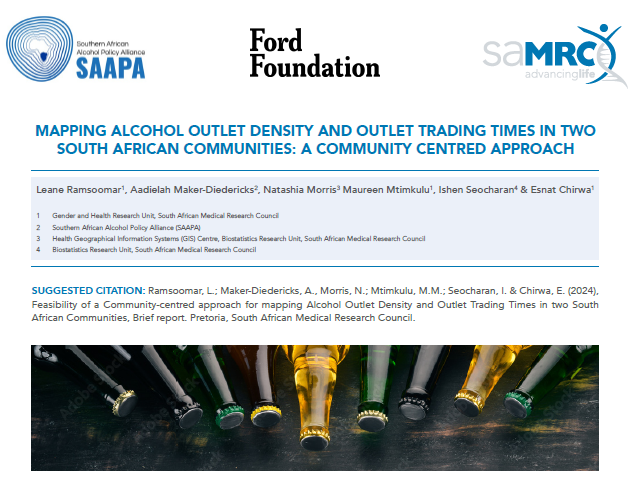Mapping Alcohol Outlet Density and Outlet Trading Times in Two South African Communities: A Community Centred Approach

Mapping Alcohol Outlet Density and Outlet Trading Times in Two South African Communities: A Community Centred Approach
Harm due to alcohol use is strongly associated with the availability, accessibility and affordability of alcohol in communities. The World Health Organisation (WHO) recommends that public health efforts must seek to reduce the availability of alcohol in order to reduce consumption and alcohol-related harm(1). This study focused on alcohol availability by examining alcohol outlet densities (AOD) - defined as a high concentration of alcohol outlets in a small area and outlet trading times (OTT), in two South African communities.
In South Africa, the issue of alcohol availability is particularly pressing, where the proliferation of alcohol outlets results from a range of phenomena, including the socio-political history of South Africa, which resulted in spatial planning that was separatist, forcing the majority of the population into townships with limited or no social spaces; the “dop3” system which paid farm workers in alcohol in exchange for employment, the rise of migrant work in mines, and the availability of cheap alcohol (mainly wine) to workers to promote job retention(2). In addition, interference from the alcohol industry in alcohol policy-making, aggressive marketing, and overt expansionist strategies to penetrate the African market combine with South Africa’s socio-political history to result in the mushrooming of alcohol outlets and increased alcohol availability, particularly in local communities. The government’s economic policy which promotes Broad- Based Black Economic Empowerment (B-BBEE) and job creation through the alcohol industry also contributes to the acceptance of alcohol trade, including through unlicensed trading in communities.(3) In addition, the high number of unlicenced outlets often means that alcohol is bought and sold outside of the regulated trading times. A rise in the numbers and density of alcohol outlets and increased availability through longer outlet trading times is associated with a range of negative consequences, including; violent crime (4, 5); gender-based violence(6); alcohol -related injuries (7) motor vehicle accidents and fatalities(8) among others. Increasingly the role of alcohol use, particularly excessive alcohol use has featured as a salient risk factor for gender-based violence.
View the complete Mapping Alcohol Outlet Density and Outlet Trading Times in Two South African Communities: A Community Centred Approach Policy Brief
